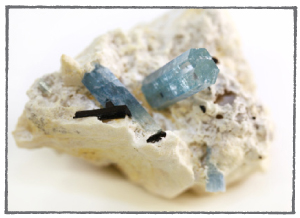AQUAMARINE

A VARIETY OF THE MINERAL BERYL, aquamarine means “sea water.” It is thought to have been named for its pale blue tones. Although it can also exhibit secondary hues of yellow and green, aquamarine is often heat-treated to create a bluer stone for use in the gem trade. It is popular and is most often faceted to accentuate the stone’s color. Mined in Brazil, Africa, and North America, the stone often occurs in clean, well-formed crystals prized by mineral collectors. Large specimens of aquamarine are not uncommon, and some huge crystals have been found, including the Dom Pedro, which stood more than twenty-three inches tall before it was sculpted by famed gem-cutter Bernd Munsteiner.
Ancient texts do not refer to aquamarine by name, and we believe that the stone was referred to as “sea green beryl” or “water sapphire.” The first use of the modern name was by Anselmus de Boodt in his 1609 manuscript Gemmarum et Lapidum Historia. The stone was widely used for medicinal purposes and as an oracle throughout the Middle Ages, and mariners, who believed it to be a gift of the mermaids, wore amulets of aquamarine engraved with the likeness of Poseidon, the sea god, to protect them. It was also common practice for sailors to carry small stones with them to toss into tempestuous seas to appease Poseidon. Even today, aquamarine is thought to protect sailors and fishermen alike.
Aquamarine is the modern birthstone for March and is linked to Scorpio. Its metaphysical properties are thought to be empowerment and facilitating clear communication.